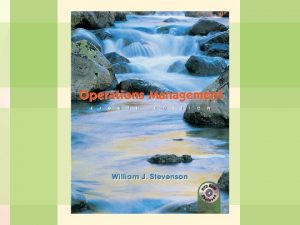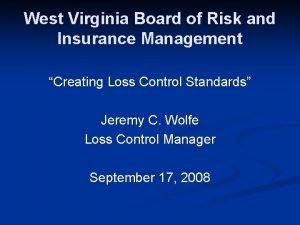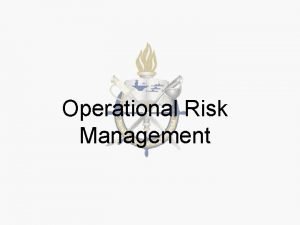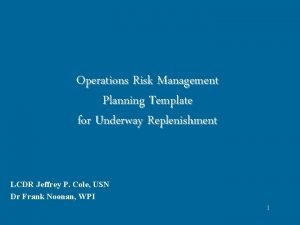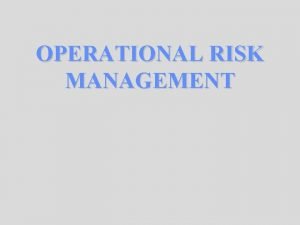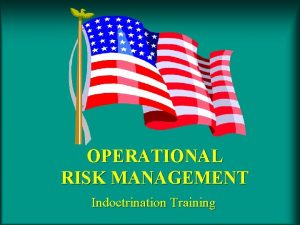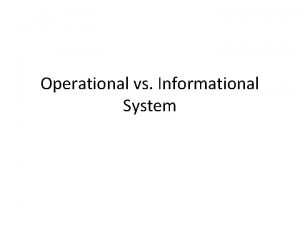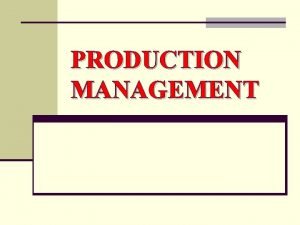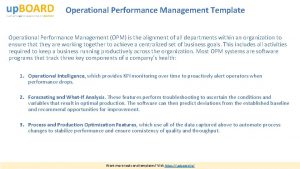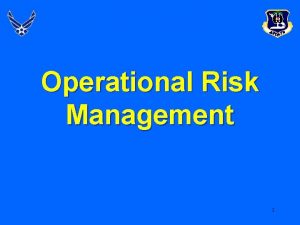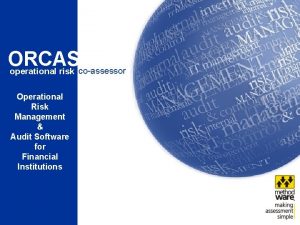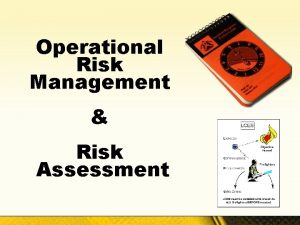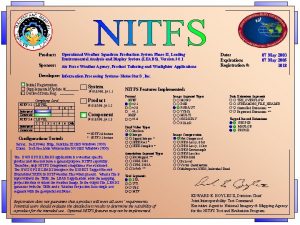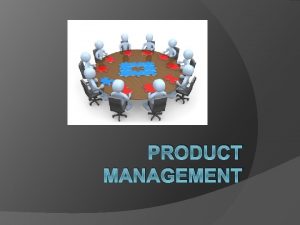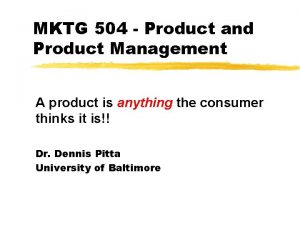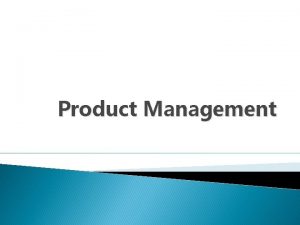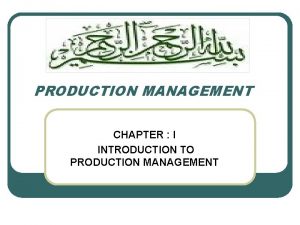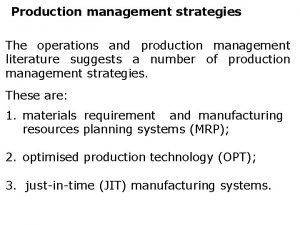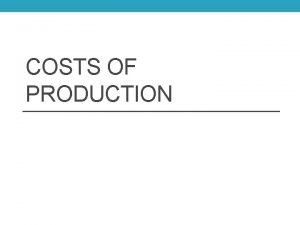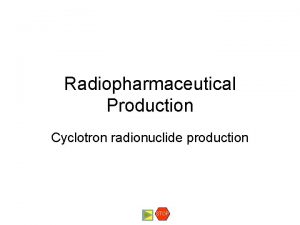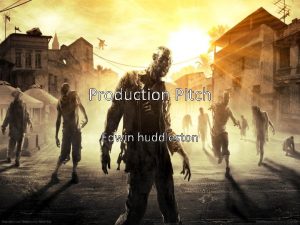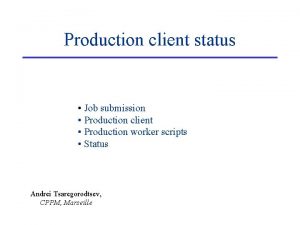PRODUCTION OPERATIONAL MANAGEMENT Product The product is an

































- Slides: 33

PRODUCTION & OPERATIONAL MANAGEMENT

Product The product is an output obtained by transforming the inputs like materials & labour. Product have a value in exchange.

Product Vs Service I. II. IV. Product Physical outputs Quality measured directly There may be time gap between production & consumption of the product. Standardized output Service I. Non-physical outputs II. Quality perceived and difficult to measure III. Service do not exist until they are provided at the call of the customer. IV. Customized output

Product Vs Service V. Capital intensive VI. Products can be evaluated against specification & criteria V. Labour intensive VI. Service quality is evaluated against the satisfaction of the customer.

Goods Contain Services / Services Contain Goods Automobile Computer Installed Carpeting Fast-food Meal Restaurant Meal Auto Repair Hospital Care Advertising Agency Investment Management Consulting Service Counseling 100 75 50 25 50 75 100 Percent of Product that is a Good Percent of Product that is a Service

Production is a process of making products. In production, different inputs like materials, human, capital & other resources are transformed into higher value goods & services.

Working of Production System E N V I R O N M E N T I N P U T S P L A N N I N G S C H E D U LING C O N T R O LING O U T P U T E N V I R O N M E N T

What is Production Management According to H. A. Harding “Production Management is concerned with those processes which convert the inputs into outputs. The inputs are various resources like raw materials, men, machines, methods, etc. and outputs are goods and services. ” According to E. S. Buffa, “ Production Management deals with decisions making related to production process so that the resulting goods or service is produced according to specifications, in the amounts and by the schedule demanded & at minimum cost. ”

Scope/Functions of Production Management Production Design & Development of Production Process(Fabricating & Assembly process & Analytical, synthetic, & modifying process) Production Planning & Control Purchasing Plan implementation Inventory Control

Objectives of Production Management 1) 2) 3) 4) Primary Objectives Quality Quantity CostPrice Time

1) 2) 3) 4) 5) Secondary Objectives Men Machines Materials Services Techniques

Operations Management ü ü Operations is a process of changing inputs into output with the creation or adding value to some entity An operation management is the systematic design, direction & control of the processes that transform inputs into services & products for the customers. It encompasses all management activities using resources such as Plants People Parts Processes

Operations Management is: A management Core function In every organization whether Service or Manufacturing, profit or Not for profit

Production & operation Management It is defined as design, operations & improvement of transformation process which converts various inputs to outputs.

Ten Decision Areas of POM Goods & Services Design 2. Process & Capacity Design 3. Location Selection 4. Layout Design 5. Human Resource and Job Design 6. Supply-chain Management 7. Inventory 8. Scheduling 9. Quality 10. Maintenance 1.

What is Role of OM? OM Transforms inputs to outputs Inputs are resources such as People, Outputs Material, and Money are goods and services

OM’s Transformation Process

Transformation process for a purely service organization Inputs §Raw minds (students) §Teachers §Administrative staff §Classrooms §Computer lab §Library §Projectors Quality of output monitored Quality of input monitored Transformation Process Feedback Mechanisms §Success at Placement interviews §Grades obtained in examination §Rising career graph of alumni in corporate §Number of applications for admission in the institute §Rating of surveys Output Enlightened students with §Good communicatio n skills §Good analytical ability §Team sprit §Decision making ability

Transformation process for a purely manufacturing organization Inputs §Machines & equipments §Components, parts, sub assemblies §Packaging material §capital §Building §Workers §managers Quality of output monitored Quality of input monitored Transformation Process Feedback Mechanisms §Rising sales volumes §Lesser customer complaints §Positive response of customers in the feedback forms Output Refrigerators with §Good cooling performance §Less consumptions of electricity §Genuine prices §New advance features

OM’s Transformation Role To add value Increase product value at each stage Value added is the net increase between output product value and input material value Provide an efficient transformation Efficiency – means performing activities well for least possible cost

Functions of operations mgt Planning Organizing Controlling Behaviour Models

Ops. Mgmt. Decisions

4 Important Operations Strategies Will you compete on – Cost? Quality? Response? Flexibility? All of the above? Some? Tradeoffs?

Competing on Cost? Limit product range & offer little customization Automation to reduce unit costs Better designs of products/services

Competing on Quality? High performance design: Superior features, high durability & excellent customer service Product & Service consistency: Meets design specifications Improved technology Error free delivery

Competing on Responsiveness? Fast delivery: Shorter On-time delivery: Deliver time between order and delivery product exactly when needed Rapid development speed Using concurrent processes to shorten product development time

Competing on Flexibility? Product flexibility: Easily switch production from one item to another Easily customize product/service to meet specific requirements of a customer Volume flexibility: Ability to ramp production up and down to match market demands

Classification of Operations Classification of operations Continuous Semi. Continuous Intermittent process Batch Process Project Job Shop

1. Continuous Process Continuous process has long set up time & once started, they continue for a long duration. Products are standarised with almost no variety. It is normally associated with large quantities and with high rate of demand. Examples : Urea, chemicals, detergents, sugar, textile, etc. industries are based on continuous process

2. Semi continuous process These are assembly processes, which are repitative in nature. Products have high volume & with little variety. These processes require highly specialized machines, semi skilled labour. Examples: automobiles, electronic items, etc.

3. Intermittent processes stop at regular intervals of time because the product require processing of variety of machines. Intermittent processes are of two types: Batch process: this process is adopted when batches or lots or items are produced using the same set of machines in same sequence. E. g. bakery etc Job Shop: Products are produced as per the specification of customers within prefixed time and cost. The distinguishing feature of this is

4. Project shop Projects are processes that handle very complex & unique sets of activities or tasks which have to be completed in limited span of time. Example: R & D projects, building complexes, etc.

Duties & Responsibilities of Operational manager understanding strategic objectives Developing an operations strategy Designing the operation's products, services and processes Purchasing product equipments Product design Capacity Planning and inventory controlling Improving the performance of operation Quality control Budgeting & capital planning
 Jelaskan 3 proses alur produksi multimedia
Jelaskan 3 proses alur produksi multimedia Operational risk management worksheet
Operational risk management worksheet Jit building blocks
Jit building blocks West virginia board of risk and insurance management
West virginia board of risk and insurance management Orm abcd model
Orm abcd model Operational risk management plan template
Operational risk management plan template Operational risk management worksheet
Operational risk management worksheet Benefits of operational risk management
Benefits of operational risk management 5 step orm process
5 step orm process Hình ảnh bộ gõ cơ thể búng tay
Hình ảnh bộ gõ cơ thể búng tay Ng-html
Ng-html Bổ thể
Bổ thể Tỉ lệ cơ thể trẻ em
Tỉ lệ cơ thể trẻ em Chó sói
Chó sói Chụp tư thế worms-breton
Chụp tư thế worms-breton Chúa yêu trần thế alleluia
Chúa yêu trần thế alleluia Các môn thể thao bắt đầu bằng tiếng bóng
Các môn thể thao bắt đầu bằng tiếng bóng Thế nào là hệ số cao nhất
Thế nào là hệ số cao nhất Các châu lục và đại dương trên thế giới
Các châu lục và đại dương trên thế giới Công thức tiính động năng
Công thức tiính động năng Trời xanh đây là của chúng ta thể thơ
Trời xanh đây là của chúng ta thể thơ Cách giải mật thư tọa độ
Cách giải mật thư tọa độ Làm thế nào để 102-1=99
Làm thế nào để 102-1=99 Phản ứng thế ankan
Phản ứng thế ankan Các châu lục và đại dương trên thế giới
Các châu lục và đại dương trên thế giới Thể thơ truyền thống
Thể thơ truyền thống Quá trình desamine hóa có thể tạo ra
Quá trình desamine hóa có thể tạo ra Một số thể thơ truyền thống
Một số thể thơ truyền thống Cái miệng nó xinh thế
Cái miệng nó xinh thế Vẽ hình chiếu vuông góc của vật thể sau
Vẽ hình chiếu vuông góc của vật thể sau Thế nào là sự mỏi cơ
Thế nào là sự mỏi cơ đặc điểm cơ thể của người tối cổ
đặc điểm cơ thể của người tối cổ V cc cc
V cc cc Vẽ hình chiếu đứng bằng cạnh của vật thể
Vẽ hình chiếu đứng bằng cạnh của vật thể


